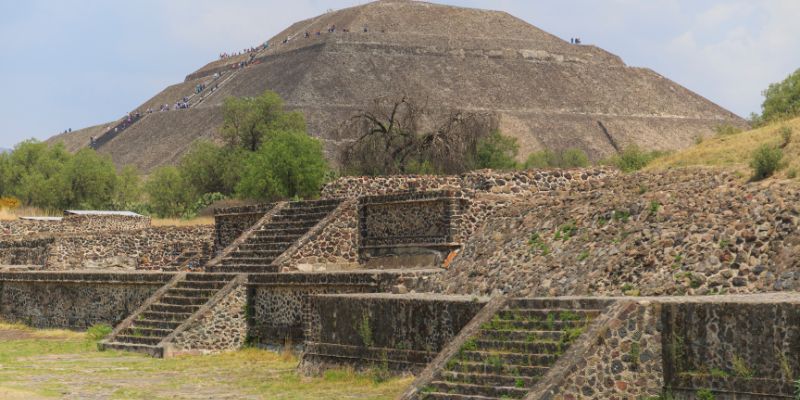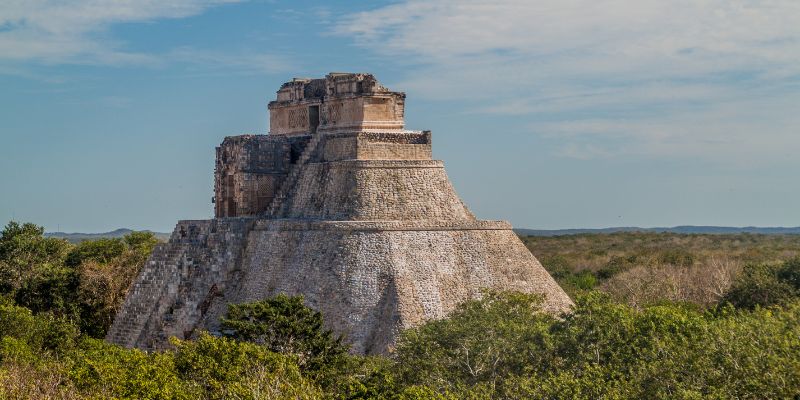Mexico is rich in history and culture, with ancient civilizations like the Maya and Aztecs leaving behind spectacular architectural marvels.
It is home to some of the most spectacular pyramid structures ever built in the Western Hemisphere. Mexico's majestic pyramids provide a glimpse into Mesoamerican cultures' scientific knowledge and engineering abilities.
In this article, we explore the 6 most amazing in Mexico. So continue reading.

6 Most Amazing Pyramids to See in Mexico: The Ancient Wonders
1. Pyramid Of The Sun And Pyramid Of The Moon, Teotihuacan
The Pyramid of the Sun and the Pyramid of the Moon in Teotihuacan are two of Mexico's most iconic and impressive pyramids. Built around 100 CE, these massive structures were fundamental to one of Mesoamerica's largest and most influential ancient cities.
The Pyramid of the Sun is the third largest pyramid in the world and dominates the landscape of Teotihuacan. The Pyramid of the Sun is one of the largest in the world, reaching over 200 feet tall and dominating the landscape. Climbing its 243 steep steps rewards you with awe-inspiring views. It was one of the tallest structures ever built in the pre-Columbian Americas.
The Pyramid of the Moon is smaller but equally remarkable with its series of terraces and unique aesthetic. Its terraced design and placement along the Avenue of the Dead point is perfect so that it can be used for ritual functions.
Both pyramids were strategically built to align with astronomical phenomena, revealing the remarkable scientific knowledge of Teotihuacan's people. Underneath the Pyramids are networks of caves and tunnels that can be explored today.
2. El Castillo, Chichen Itza
One of the most famous pyramids in Mexico is El Castillo, located in the ancient Mayan city of Chichen Itza. The Toltec-Maya built it between 1050 and 1300 CE.
This monumental structure is also known as the Temple of Kukulcan and stands 79 feet tall. It has four sides, each with 91 steps. The total steps add up to 365, reflecting the Mayan solar calendar.
An intriguing light-and-shadow display occurs on the steps during the spring and autumn equinoxes, creating the illusion of a serpent body undulating the pyramid. This phenomenon emphasizes El Castillo’s astronomical significance to the Mayans.
The intricate stone carvings and temple atop the pyramid provide insight into Mayan religious beliefs and rituals.
Climbing the pyramid’s steep steps allows you to gaze out over the magnificent ruins of Chichen Itza and contemplate the remarkable engineering abilities of Mayan builders. In 2007, El Castillo was voted one of the New Seven Wonders of the World, confirming its status as one of Mexico’s most spectacular ancient monuments.
3. Pyramid Of The Insciptions, Palenque
The Pyramid of the Inscriptions in the ancient Mayan city of Palenque is one of the most famous pyramid in Mexico. This impressive stepped structure contains an elaborate tomb dedicated to Palenque's ruler, K'inich Janaab' Pakal. He was one of Palenque's greatest rulers, buried deep inside the pyramid upon his death in 683 CE.
The tomb, discovered in 1952, consists of a staircase leading down into a passageway filled with intricate carvings and hieroglyphics that attest to Mayan beliefs about the afterlife. Amazingly preserved bas-relief sculptures and Pakal's iconic sarcophagus can be seen in the tomb. They offer rare insights into Mayan funerary practices.
The pyramid stands 60 meters tall, with a striking facade of nine steep levels. Climbing to the top of the pyramid provides scenic views of Palenque's sprawling ruins surrounded by tropical forests.
This pyramid reveals the accomplishments of Mayan civilization at its height and makes this pyramid a must-see highlight of any visit to Palenque.
4. Pyramid of Quetzalcoatl, Tula
The Pyramid of Quetzalcoatl is an integral part of the ancient Toltec capital of Tula. It was built between 900-1150 CE. This stepped, four-sided pyramid is dedicated to the important Mesoamerican deity Quetzalcoatl, the Feathered Serpent.
The structure is imposing yet elegantly designed, standing over 16 meters tall. The carved serpents adorning the pyramid have given it the nickname "Pyramid of the Morning Star." The Toltecs were particularly skilled stoneworkers; these carvings and architectural style reflected their advanced abilities.
One unique feature is the hollow nature of the pyramid, with a series of chambers and tunnels inside it that visitors can explore today. The pyramid's placement at the heart of Tula highlights the significance of Quetzalcoatl worship in Toltec society.
The base of the pyramid is rectangular rather than square. The building is topped by five-tiered groupings of columns on each side leading up to the temple at the summit.
Climbing to the top provides views of the entire archaeological zone, letting you appreciate the massive scale of this ancient city.

5. Pyramid Of The Magician, Uxmal
The ancient Mayan city of Uxmal is home to the unique Pyramid of the Magician, also called the Pyramid of the Dwarf. This distinct pyramid stands an impressive 115 feet tall, with an oval base and steep sides that rise to the temple at the top. Unlike most Mesoamerican pyramids, this structure is oval-shaped when viewed from above.
According to legends, the pyramid was magically constructed in one night by a dwarf wizard. In reality, it was built in stages in the 6th century CE. The western facade contains various decorative elements, including vibrant masks of the rain god Chaac.
The pyramid's western face can be climbed, allowing access to stunning panoramic views over Uxmal's UNESCO World Heritage Site. Climbing the pyramid's steep western face rewards you with panoramic views of Uxmal's beautiful complex of ruins emerging from the Yucatán jungle canopy.
6. The Great Pyramid Of Cholula
The Great Pyramid of Cholula, also known as Tlachihualtepetl, is the largest pyramid ever built in volume. This ancient structure was built in several phases starting around the 3rd century BCE and is the biggest pyramid in Mexico. It measures over 1,400 feet wide at the base and is over 200 feet tall.
Unlike some Mesoamerican pyramids, the Great Pyramid of Cholula has a more rounded shape with a flat top. While not as visually imposing from the outside, the enormous size becomes clear from aerial views.
The pyramid is just one part of a vast ancient complex where multiple cultures lived consecutively, including the Olmecs, Toltecs, Aztecs, and others. Inside the pyramid is an astonishing network of tunnels stretching over 6 miles.
Conclusion
Most amazing pyramids in Mexico are testaments to the ingenuity, astronomy, and engineering skills of cultures like the Maya, Aztecs, and others who inhabited this region centuries ago. One cannot help but feel an awe-inspired connection to the past when exploring Mexico's archaeological treasures.

Juliana Daniel Jan 03, 2023
Things To Do And See In Atlantic City, New Jersey

Juliana Daniel Dec 25, 2022
A Full Day Tour To Capri From The Amalfi Coast

Sean William Dec 26, 2022
List of Europe's Top UNESCO World Heritage Sites

Juliana Daniel Aug 28, 2023
China Travel Guide

Juliana Daniel Jan 03, 2023
Top Attractions In Asheville, North Carolina

Sean William Dec 25, 2022
Ecotourism Will Help You Explore Karpathos

Juliana Daniel Dec 25, 2022
Miami, Florida: What To Do In One Day

Juliana Daniel Dec 25, 2022